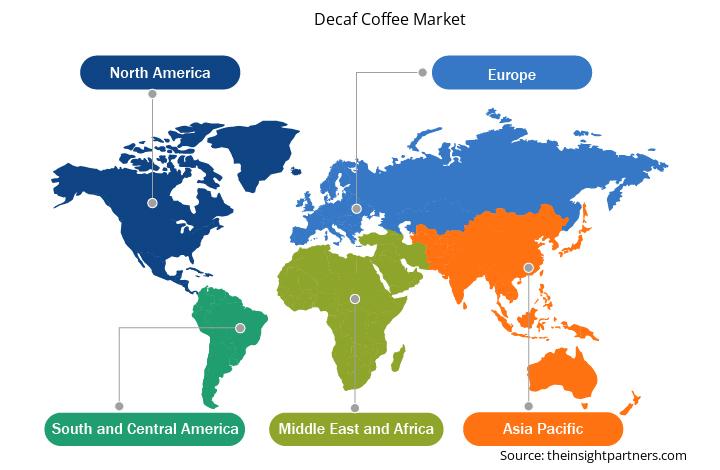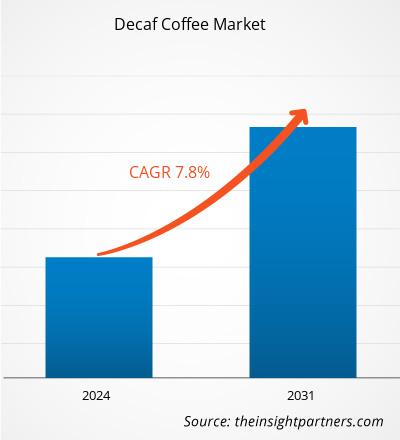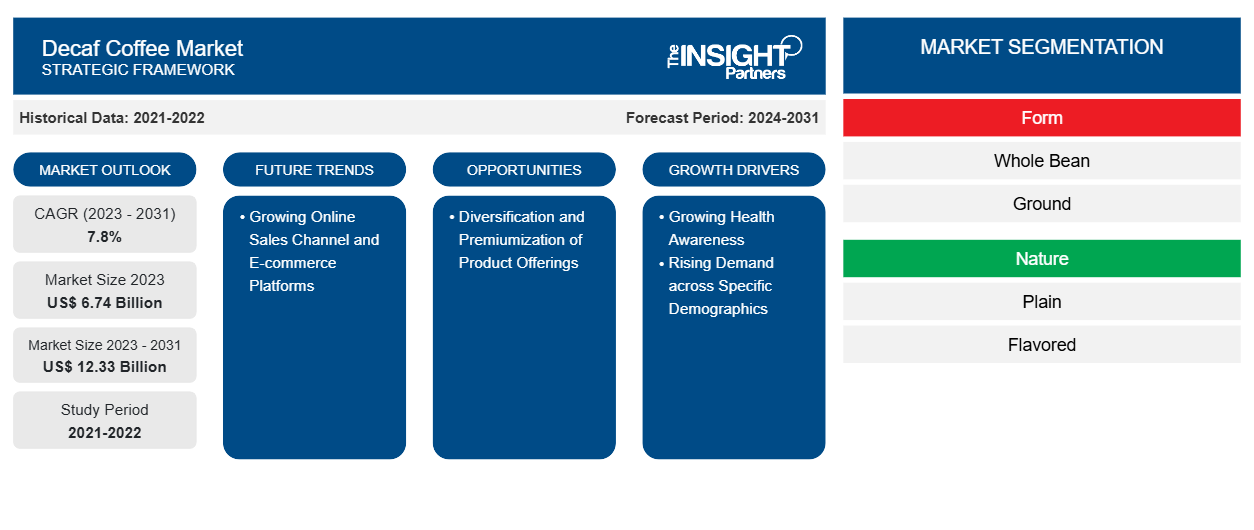디카페인 커피 시장 규모는 2023년 67억 4천만 달러에서 2031년까지 123억 3천만 달러에 이를 것으로 예상됩니다. 이 시장은 2023~2031년 동안 7.8%의 CAGR을 기록할 것으로 예상됩니다. 제품 제공의 다각화와 프리미엄화는 예측 기간 동안 시장에 새로운 트렌드를 가져올 가능성이 높습니다.
디카페인 커피 시장 분석
건강과 웰빙에 대한 관심 증가와 젊은 성인의 건강 음료 에 대한 성향 증가로 인해 디카페인 커피에 대한 수요가 증가하고 있습니다. 임산부는 디카페인 커피 시장에서 중요한 소비자 그룹입니다. 게다가 디카페인 커피 시장은 임산부가 유산 및 저체중 출산과 같은 카페인 관련 위험을 피할 수 있는 매력적인 기회를 제공합니다. 디카페인 커피는 이 인구통계학적 집단이 부작용 없이 커피 일상을 계속 즐길 수 있는 솔루션을 제공합니다. 특정 인구통계학적 집단에서 디카페인 커피 소비가 증가하고 건강에 대한 인식이 높아지면서 디카페인 커피 시장이 성장할 것으로 예상됩니다.
디카페인 커피 시장 개요
디카페인 커피는 카페인을 제거하는 과정을 거친 일반 커피콩으로 만들어집니다. 이 과정에는 녹색 커피콩을 용매에 담가 카페인을 추출하는 과정이 포함됩니다. 그런 다음 커피콩을 헹구고 말려 남아 있는 용매와 카페인 잔여물을 제거합니다. 소비자들 사이에서 건강과 웰빙에 대한 관심이 커지면서 디카페인 커피에 대한 수요가 늘어나고 있으며, 이는 일반 커피보다 건강한 대안으로 인식되고 있습니다. 플레이버 라떼와 콜드브루와 같은 디카페인 커피 맛의 제품 혁신이 확대되면서 여러 소비자가 관심을 갖고 시장 성장이 촉진되고 있습니다. 또한 가처분 소득이 증가하고 프리미엄 제품에 대한 수요가 늘어나면서 글로벌 디카페인 커피 시장에 대한 수요가 증가하고 있습니다.
귀하의 요구 사항에 맞게 이 보고서를 사용자 정의하세요
이 보고서의 일부 또는 국가 수준 분석, Excel 데이터 팩을 포함하여 모든 보고서에 대한 사용자 정의를 무료로 받을 수 있으며 신생 기업 및 대학을 위한 훌륭한 혜택과 할인 혜택을 이용할 수 있습니다.
-
이 보고서의 주요 시장 동향을 알아보세요.이 무료 샘플에는 시장 동향부터 추정 및 예측까지 다양한 데이터 분석이 포함됩니다.
디카페인 커피 시장 동인 및 기회
건강에 대한 인식 확대
점점 더 많은 소비자들이 카페인 섭취로 인한 불안, 불면증, 소화 문제와 같은 부작용을 경험하고 있습니다. 과도한 커피는 떨림, 메스꺼움 , 구토, 복통, 빠른 호흡, 불규칙한 심박수, 공황 발작, 발작과 같은 여러 가지 건강 문제를 일으킵니다. 지난 몇 년 동안 주요 시장 참여자들은 다양한 종류의 디카페인 커피를 출시하여 이러한 과제에 뛰어들었습니다. 디카페인 커피는 카페인 함량이 줄거나 전혀 없는 일반 커피의 맛과 경험을 제공하므로 건강을 의식하는 사람들 사이에서 점점 더 인기 있는 선택이 되고 있습니다. 디카페인 커피는 부작용 없이 커피를 즐길 수 있는 대안을 제공합니다. 카페인을 과도하게 섭취하면 불안과 스트레스를 유발할 수 있습니다. 디카페인 커피는 커피 마시는 습관을 유지하면서 카페인 부하를 줄여 정신적 웰빙을 지원합니다. 좋은 수면에 대한 강조가 커지면서 디카페인 커피는 카페인이 수면에 미치는 부작용을 피하기 위한 커피에 대한 대안 솔루션이 되었습니다.
FSSAI, 식품 안전 및 응용 영양(CFSAN), 유럽 식품 안전 기관(EFSA)과 같은 규제 기관은 임신 및 수유 중인 여성, 어린이, 청소년, 젊은 성인 및 기저 심장 및 기타 건강 문제가 있는 사람들의 커피 소비 위험을 강조했습니다. Zydus Medical College and Hospital의 연구에 따르면, 규칙적인 카페인 소비는 부교감 신경계를 교란하여 혈압과 심박수를 높입니다. 자율 신경계에 미치는 영향으로 인해 규칙적인 카페인 소비는 고혈압 및 기타 심혈관 질환의 위험을 증가시킬 수 있습니다. 게다가 British Coffee Association에 따르면, 커피 마시는 사람 5명 중 1명이 정기적으로 디카페인 커피를 마신다. 따라서 증가하는 건강 인식이 글로벌 디카페인 커피 시장을 주도하고 있습니다.
온라인 판매 채널과 전자 상거래 플랫폼의 증가
디카페인 커피는 건강 의식 증가, 라이프스타일 변화, 저카페인 대체품 수요로 인해 관심이 급증하고 있습니다. 전자상거래 플랫폼의 증가는 소비자 기반이 확대되면서 시장에 혁명을 일으키고 있습니다. 식품 산업 협회에 따르면 미국에서 판매된 총 식료품의 6.0%가 온라인 판매 채널을 통해 이루어졌습니다. 게다가 미국에서 온라인 식료품 쇼핑객(여성) 수는 2023년 62%에서 2024년 66%로 증가했습니다. 미국에서 X세대 온라인 식료품 쇼핑객 수는 2023년 65%에서 2024년 70%로 증가했습니다. 전자상거래는 제품 가시성에 크게 기여하여 시장 도달 범위를 확대하고 소비자 참여를 심화시킵니다. 또한 미개척 시장 진입을 용이하게 합니다. 온라인 판매 채널은 또한 브랜드가 단일 제공 포드, 특수 블렌드, 유기농 옵션과 같은 혁신적인 디카페인 커피 형식을 실험하는 데 도움이 됩니다. 인공지능의 통합과 전자상거래의 데이터 중심적 특성은 또한 브랜드가 구매 행동을 분석하고 제품 제공을 개선할 수 있도록 합니다. 커피 구독 문화의 부상은 시장 성장에 상당한 기회를 제공합니다. 전자상거래는 디카페인 커피 시장에서 브랜드 스토리텔링과 투명성을 증폭합니다. 브랜드는 제품 설명을 활용하여 지속 가능성, 공정 무역 및 건강상의 이점에 대한 의지를 효과적으로 전달합니다. 따라서 온라인 판매 채널과 전자상거래 플랫폼의 성장은 시장 성장에 수익성 있는 기회를 창출할 것으로 예상됩니다.
디카페인 커피 시장 보고서 세분화 분석
디카페인 커피 시장 분석에 기여한 핵심 세그먼트는 형태, 특성, 범주, 유통 채널입니다.
- 형태에 따라 디카페인 커피 시장은 통두, 분쇄, 기타로 세분화됩니다. 분쇄 세그먼트가 2023년 시장을 지배했습니다.
- 디카페인 커피 시장은 본성에 따라 플레인과 플레이버로 세분화됩니다. 플레이버 세그먼트가 2023년 시장을 지배했습니다.
- 카테고리에 따라 시장은 유기농과 재래식으로 세분화됩니다. 재래식 세그먼트가 2023년 시장을 지배했습니다.
- 유통 채널을 기준으로 시장은 슈퍼마켓과 하이퍼마켓, 편의점, 온라인 소매 및 기타로 세분화됩니다. 슈퍼마켓과 하이퍼마켓 세그먼트는 2023년에 시장을 지배했습니다.
지역별 디카페인 커피 시장 점유율 분석
디카페인 커피 시장 보고서의 지리적 범위는 주로 북미, 아시아 태평양, 유럽, 중동 및 아프리카, 남미 및 중부 아메리카의 5개 지역으로 나뉩니다.
유럽은 디카페인 커피 시장을 지배했습니다. 유럽에서는 건강과 웰빙에 대한 강조가 커지면서 균형 잡힌 식단을 섭취하는 것의 중요성에 대한 인식이 높아졌습니다. 독일, 영국, 이탈리아와 같은 국가는 시장 성장에 크게 기여합니다. 고품질의 장인 제품을 선호하는 소비자는 특수 디카페인 커피에 대한 수요를 촉진합니다. 특히 노령 인구의 건강 추세와 유기농 및 공정 무역 인증에 대한 집중도가 높아지면서 시장이 형성되고 있습니다. 편리성과 홈 양조 시스템과의 호환성으로 인해 디카페인 커피 포드와 캡슐의 채택이 증가하고 있습니다.
디카페인 커피 시장 지역별 통찰력
Insight Partners의 분석가들은 예측 기간 동안 디카페인 커피 시장에 영향을 미치는 지역적 추세와 요인을 철저히 설명했습니다. 이 섹션에서는 북미, 유럽, 아시아 태평양, 중동 및 아프리카, 남미 및 중미의 디카페인 커피 시장 세그먼트와 지리에 대해서도 설명합니다.

- 디카페인 커피 시장의 지역별 데이터 얻기
디카페인 커피 시장 보고서 범위
| 보고서 속성 | 세부 |
|---|---|
| 2023년 시장 규모 | 67억 4천만 달러 |
| 2031년까지 시장 규모 | 123억 3천만 달러 |
| 글로벌 CAGR (2023-2031) | 7.8% |
| 역사적 데이터 | 2021-2022 |
| 예측 기간 | 2024-2031 |
| 다루는 세그먼트 |
형태로
|
| 포함된 지역 및 국가 |
북아메리카
|
| 시장 선도 기업 및 주요 회사 프로필 |
|
디카페인 커피 시장 참여자 밀도: 비즈니스 역학에 미치는 영향 이해
디카페인 커피 시장은 소비자 선호도의 변화, 기술 발전, 제품의 이점에 대한 인식 증가와 같은 요인으로 인해 최종 사용자 수요가 증가함에 따라 빠르게 성장하고 있습니다. 수요가 증가함에 따라 기업은 제품을 확장하고, 소비자의 요구를 충족하기 위해 혁신하고, 새로운 트렌드를 활용하여 시장 성장을 더욱 촉진하고 있습니다.
시장 참여자 밀도는 특정 시장이나 산업 내에서 운영되는 회사나 기업의 분포를 말합니다. 주어진 시장 공간에 얼마나 많은 경쟁자(시장 참여자)가 존재하는지 그 규모나 총 시장 가치에 비해 나타냅니다.
디카페인 커피 시장에서 활동하는 주요 회사는 다음과 같습니다.
- 네슬레 SA
- 일리카프 SpA
- 루이지 라바짜 스파
- 크래프트 하인츠 주식회사
- 신선한 로스트 커피 유한회사
- 라이프부스트 커피 유한회사
면책 조항 : 위에 나열된 회사는 어떤 특별한 순서에 따라 순위가 매겨지지 않았습니다.

- 디카페인 커피 시장의 주요 기업 개요를 알아보세요
디카페인 커피 시장 뉴스 및 최근 동향
디카페인 커피 시장은 1차 및 2차 조사 이후의 질적, 양적 데이터를 수집하여 평가합니다. 여기에는 중요한 기업 간행물, 협회 데이터, 데이터베이스가 포함됩니다. 디카페인 커피 시장의 몇 가지 개발 사항은 다음과 같습니다.
- 네슬레 베트남은 동나이 남부 지방에 위치한 Tri An 커피 공장의 생산 용량을 늘리기 위해 1억 달러를 투자한다고 발표했습니다. 이를 통해 회사는 고품질 커피에 대한 국내 및 국제 소비자 수요를 충족하는 데 도움이 될 것입니다. (출처: Nestlé SA, 보도자료, 2024년 1월)
- JDE Peet는 Caribou 커피숍을 제외한 Caribou 브랜드 커피 제품을 제조, 마케팅 및 판매하기 위한 장기 글로벌 라이선스 계약을 체결했습니다. 2024년 1분기에 마감될 것으로 예상되는 이 계약은 북미에서 JDE Peet의 프리미엄 커피 제품을 강화하는 것을 목표로 합니다. (출처: Nestlé SA, 보도자료, 2024년 1월)
디카페인 커피 시장 보고서 범위 및 제공물
"디카페인 커피 시장 규모 및 예측(2021-2031)" 보고서는 아래 영역을 포괄하는 시장에 대한 자세한 분석을 제공합니다.
- 범위에 포함된 모든 주요 시장 세그먼트에 대한 글로벌, 지역 및 국가 수준의 디카페인 커피 시장 규모 및 예측
- 디카페인 커피 시장 동향과 이를 주도하는 요인, 제약, 주요 기회와 같은 시장 역학
- 포터의 5가지 힘 분석 및 SWOT 분석에 대한 자세한 설명
- 주요 시장 동향, 글로벌 및 지역 프레임워크, 주요 업체, 규정 및 최근 시장 개발 사항을 다루는 디카페인 커피 시장 분석
- 시장 집중도, 히트맵 분석, 유명 업체, 디카페인 커피 시장의 최근 동향을 다루는 산업 환경 및 경쟁 분석
- 자세한 회사 프로필
- 과거 분석(2년), 기준 연도, CAGR을 포함한 예측(7년)
- PEST 및 SWOT 분석
- 시장 규모 가치/거래량 - 글로벌, 지역, 국가
- 산업 및 경쟁 환경
- Excel 데이터세트
최근 보고서
관련 보고서
사용 후기
구매 이유
- 정보에 기반한 의사 결정
- 시장 역학 이해
- 경쟁 분석
- 고객 인사이트
- 시장 예측
- 위험 완화
- 전략 기획
- 투자 타당성 분석
- 신흥 시장 파악
- 마케팅 전략 강화
- 운영 효율성 향상
- 규제 동향에 발맞춰 대응























 무료 샘플 받기 - 디카페인 커피 시장
무료 샘플 받기 - 디카페인 커피 시장